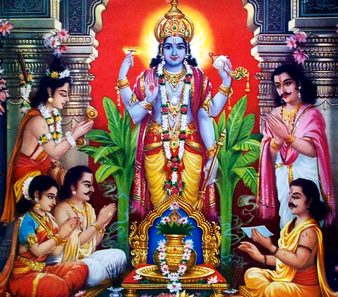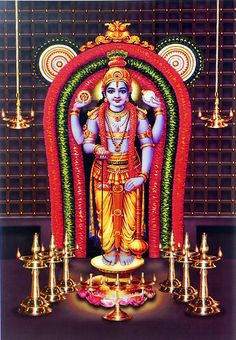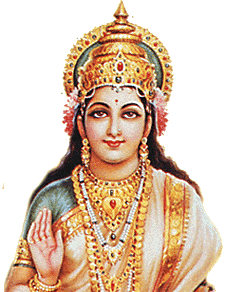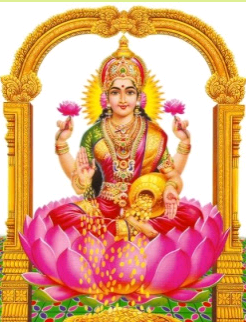Sri Satyanārayana Swāmi
Sri Satyanārāyana is the manifestation of Lord Vishnu, the sustainer of the universe, and has the same ‘Swarupa’ (form) as Lord Narayana, and He does not have any Aadhara. ‘Satyam’ stands for ‘Dharma’ or ‘Righteousness’. He sports Sanghu (Conch) and Chakra. He is endearingly worshipped in the Indian homes and abroad through the Satyanārāyana Vrata. At His feet, 108 Saligrama stones are kept. Besides Saturdays, on all full moon days, Abhishekam and Aradhanā are being performed in our temple to Lord Satyanārāyana.
The Satya Nārāyaṇa Puja is performed in reverence to the Nārāyaṇa form of Lord Viṣṇu. The Lord in this form is considered an embodiment of truth.
Performing this puja in the evening is considered more appropriate. However one can do it in the morning as well. On the day of the puja, the devotee has to fast. After bathing the person can begin the puja.
The Satya Nārāyana Puja is a Hindu religious observance. It is a ritual performed by Hindus before/on any major occasion like marriage, house warming ceremony etc. It can also be performed on any day for any reason. The Satya Nārāyana Puja is usually done on the Pūrṇimā day of every month (full moon day), Ekādaśī (11th day after full moon or new moon), Kārtika Pūrṇimā, Vaiśākhā Pūrṇimā, solar eclipse day or on Saṅkrānti except during Āṣāḍha Candra Masa. It is also done on special occasions and during times of achievements as an offering of gratitude to the Lord. These occasions include marriage, graduation, new job, and the purchase of a new home to name a few. In addition, it is said that a devotional performance of this puja will bear children to couples trying to start a family.
Summary of the puja process:
The puja starts by a prayer to Lord Gaṇeśa, to remove all obstacles that may occur as a result of incorrectly performing the puja. This is done by chanting all the names of Lord Ganesha and offering prasāda (a food offering, usually consisting of one of Lord Gaṇeśa’s favorite foods – modak, a sugar and coconut mixture, or laddu) and the showering of flower petals.
Another part of the prayer involves a prayer to the Navagraha’s – the nine important celestial beings in the universe. They consist of Sūrya – Sun, Chandra – Moon, Aṅgāraka – Mars, Buddha – Mercury, Guru – Bṛhaspati (Jupiter), Śukra – Venus, Śani – Saturn, Rāhu – North Node as the head of Svarbhānu, and Ketu – South Node as the body including the tail of Svarbhānu.
The rest of the puja consists of worship to Satya Nārāyana, an extremely benevolent form of Lord Viṣṇu. First Panchamritam is used to clean the place where the deity is placed. After placing the deity in the correct position, Satyanaraya swami is worshipped. Names of Satya Nārāyana are chanted along with offering of a variety of prasad (including a mixture of milk, honey, ghee/butter, yogurt, sugar) and flower petals.
Another requirement of the puja is that the story of the puja be heard among all those observing and partaking in the pooja. The story involves the origin of the puja, the benefits of it, and the potential mishaps that may occur with the careless performance of the puja.
The prayer concludes with an Aarti, which consists of revolving a small fire-lit-lamp in the vicinity of an image of the Lord. After the puja is over, participants and observers of the pooja are required to ingest in the prasad that was offered and blessed by the Lord.
Slokas :
sashankha chakram, sakireet kundalam, Sapeeta vastram sarasiru hekshanam,
Sahaara vaksthala kaustubha sriyam, namaami vishnum shirasa chaturbhujam.
Acyutam Keshavam Rama-Narayanam, Krishna-Damodaram, Vasudevam Harim,
Shridharam Madhavam Gopikavallabham, Janakinayakam Ramachandram bhaje.
Shantakaram bhujagashayanam, padmanabham suresham,
vishvadharam gaganasadrisham, meghavarnam shubhangam, Lakshmikantam kamalanayanam, yogibhir dhyanagamyam, vande Vishnum bhavabhayaharam, sarvalokaikanatham.
Mangalam Bhagavan Vishnu, mangalam Garuraddhvajah;
mangalam Pundarikaksho, mangalayatano Harih.





